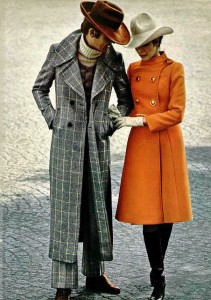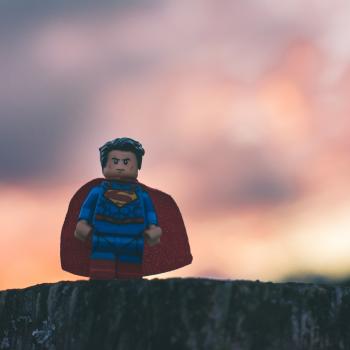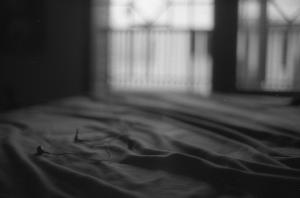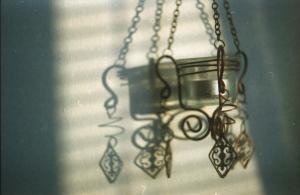 Around eight years ago, I bought a coat. I hardly ever bought brand-new clothes, and this was a real splurge on a Bible College-student budget. The coat was from Target, and it was a bright-orange corduroy plaid. I loved how it made me stand out amid the sea of black pea coats in the dreary Pacific Northwest winter.
Around eight years ago, I bought a coat. I hardly ever bought brand-new clothes, and this was a real splurge on a Bible College-student budget. The coat was from Target, and it was a bright-orange corduroy plaid. I loved how it made me stand out amid the sea of black pea coats in the dreary Pacific Northwest winter.
I come from a background of believing that fashion isn’t important at all. The larger Evangelical culture routinely rejects the body and adornments as unholy, as distracting, as weirdly sexual. Even so, I loved how the coat made me feel special, and different, and colorful.
A year or so after I bought the coat, I watched a documentary about labor practices around the world. For the first time, I started to understand the systems of oppression that modern American fashion is based around. Horrified, I swore off buying new clothes for good. I committed myself to secondhand shopping, to making do, or doing without. I started reading and learning more and more from people who were loudly opting out of the “Empire.”
I got a button with a famously acerbic quote from my new hero, Dorothy Day: “If you have two coats, you have stolen one from the poor.” The button was large and I wore it prominently on the lapel of my orange corduroy jacket. I took perverse pleasure in watching as people would lean in to read my button, then register their shock and unease as they slowly backed away from me.
I was a little bit radical, and I loved making others feel uncomfortable in their own malaise.
I wore that coat, my one and only, until I moved to the Midwest. Here, in the minus-fourteen degree winters, the wind cut through my orange corduroy coat making me feel as if I was wearing nothing at all. I went to a thrift store and bought another coat—a marshmallow dark gray no-nonsense piece of winter utilitarianism.
I now blend in with the sea of people struggling to survive the dark winters here. I still keep my orange coat, but it is only good for a month or so in the spring or the fall. The button fell off a year or so ago, so I cannot be reminded of my moral failure anymore.
A writer and activist I greatly admire makes his own clothes out of burlap (in order to escape the oppressive systems in our world). He likes to tell the story of Mother Teresa’s feet, which were badly deformed by the end of her life:
It turns out that she would always pick through the donations for the Sisters of Charity and choose the worst pair of shoes for herself, which she would wear until the shoes were in tatters. The practice ruined her feet, and no doubt caused her great physical pain. I think it is such a beautiful, horrible story. I can’t stop thinking about it, even to this day.
My thrifted clothes tend to send a message that I am opting out, but I believe in the value of giving up personal rights and preferences for the sake of the community, and as political action.
I live in an inner-city context, and work primarily within conservative Muslim communities—so I am constantly wondering how I can be inoffensive, how I can escape notice, how I can blend in. I never think about beauty in regards to my appearance, but as a way to keep anonymous, which is a way of protecting myself.
I don’t like much of my clothing, and when I look in the mirror I see that I am always dressing for somebody else. I am dressing for the men that I want to avoid interacting with on the street corner. I am dressing for my students and friends, who are extremely gratified when I wear modest, Muslim-appropriate clothing. I am dressing for a world in which I am a continual stranger, where I am formless and void, where I surround myself with loose and ill-fitting clothing, where no matter how hard I try I don’t end up fitting in.
My diverse neighborhood is home to many immigrants and refugees—the majority from East Africa. I admire the women of my community who dress with confidence and color, expressing their personalities and their cultures with their clothes: gorgeous headscarves, brightly patterned dresses, heads held high, commanding the space they inhabit.
In the lives of these women and others, there are wars, there are famines, there are labor abuses and justice issues, there are predators on the street corner; there are ever so many reasons to shut oneself off to the wonder of color and fabric and complexity. And still, day after day, women everywhere choose to pursue beauty, blessing me with their own forms of prophetic imagination.
I envy them, the ones who outwardly value both beauty and their unique contribution to the world. Not for one second, though, do I consider that I could dress like that.
But if you believe in God you must believe in beauty, and it must go hand-in-hand with neighbor love. So my current struggle is this: in the ethical, political, fractured environment we live in, how can my clothing choices reflect a love of God and of my neighbor?
While I still believe that St. Dorothy, in all of her spitfire wisdom, was right in regards to possessions, I think I misinterpreted her directive. Because my friends and neighbors, many of whom would be classified as poor, have taught me something else: beauty, they are telling me, helps us transcend this broken kingdom that we live in.
“Go ahead,” I hear them saying, “have your one coat, and make it as colorful as you can.”
I wrote the above in response to a survey by the editors of Women in Clothes, a collection of essays and vignettes exploring our relationship to clothes and how we present ourselves to the world. To find out more about the book and to read other responses (or fill out your own survey), click here.
D.L. Mayfield lives and writes in the Midwest, where she currently is a part of a Christian order among the poor. Mayfield’s writing has appeared in McSweeney’s, Image, Christianity Today, Books and Culture, and The Other Journal. Her book of essays is forthcoming from HarperOne in 2016. Learn more at http://www.dlmayfield.com/.
Photo by Bess Georgette, used under a Creative Common license.











